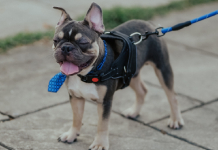With the number of people in the USA suffering from pet allergies increasing it is inevitable that breeders have tried to create a non-allergic dog breed. After all, throughout the centuries we have altered the genetics of man’s best friend to suit our needs with varying results.
The truth is there is no such thing as an allergy-free dog breed but there are quite a few which are classed as hypoallergenic dog breeds. That is, they don’t shed and can live quite happily in the home of those who normally break out in hives or have a sneezing fit at the mere mention of our furry friends.
The Labradoodle which is a cross between a Poodle and a Lab is one of these but as it is a crossbreed care must be taken, before rushing out to buy one. Do Labradoodles shed? If the puppy inherits the Labrador coat it can be anything but hypoallergenic as anyone who owns a Lab will testify. However, the Labradoodle is increasing in popularity not only with allergy sufferers but because the mix of these 2 breeds makes an excellent family pet.
Is It True, Are Labradoodles Hypoallergenic?
The answer is; usually yes. The Poodles coat is usually a dominant gene in dog genetics and the breed also only shed their dander every 3-4 weeks as opposed to other breeds that shed every few days. Not all puppies inherit the Poodles characteristics though so there are no guarantees when buying a puppy. There are various types of Labradoodle including the Australian Labradoodle and some are more hypoallergenic than others.
F1 Labradoodles
These are a cross between a Labrador and a Poodle and are equal parts of each breed. Care is needed with this generation as they can shed and are only suitable for people with mild allergies.
F1B Labradoodles
These are 1st generation Labradoodles crossed back with a Poodle producing Labradoodle puppies that are 75% Poodle which are non-shedding most of the time and are suitable for people who suffer more severe symptoms.
F2 Labradoodles
Equal parts again these are 2 first generation Labradoodles bred with each other and are again only recommended for those who suffer from mild to moderate allergies.
F2B Labradoodles
Not as common this type of Labradoodle is a first-generation doodle bred with a F1B, once again they have more Poodle in their make-up and are generally non-shedding Labradoodles that do well with moderate allergy sufferers.
Australian Multigen Labradoodle
Probably the best option for those who suffer moderate to severe allergies. These dogs have been bred for over 35 years and have a 99% success rate with allergy sufferers. They have the inclusion of other breeds including the Irish Water Spaniel, Soft coated Wheaten Terrier and Cocker Spaniel in their lines. They have been specifically bred to be non-shedding dogs and are so far away from the original Labrador that throwbacks to the parent breeds are extremely rare.
While the genetics give you an idea of what you be getting there is no substitute for spending time with your chosen Labradoodle to ensure your new best friend is itch-free.
What does hypoallergenic actually mean?
Firstly, what hypoallergenic does not mean is totally allergy-free. The word was used around 60 years ago to promote skin-care products and cosmetics. It means there is a lesser chance of a reaction, sneaky, I know but for those who insist there is no such thing as a hypoallergenic dog breed, check the definition, there are, in fact, quite a few dogs that do not have you reaching for the tissues.
3 Reasons why the Labradoodle is a Choice Breed among Allergy Sufferers
Labradoodles that inherit the famous poodle curls shed minimally, dander, dust particles and other allergens they pick up get trapped in the curls instead of becoming airborne where they cause the most problems.
The parent breeds of this mix are both highly intelligent making the Labradoodle easy to train and an excellent family companion for just about anybody.
They come in 3 sizes miniature, medium and standard so there is the perfect Labradoodle for everyone.
Labradoodles and allergies – What should I do?
Be wary of the word “hypoallergenic” while Labradoodles will trigger symptoms in some folk they may not in others and this varies with every single dog so the key is to spend time with your chosen pooch before bringing them home.
Most Labradoodle breeders are aware that many potential buyers are purchasing these puppies because a member of their family suffers from allergies and will be happy to help match you with the right Labradoodle puppy.
- Arrange visits to the breeder’s premises and spend time with your puppy, monitoring your reaction for a few days afterwards, you could even leave a t-shirt or blanket with the puppy and ask the breeder to post it too you to see if it provokes a sneezing fit.
- Make sure you purchase a puppy from a breeder who offers the option of returning the puppy if things don’t work out. The last thing you or your four-legged friend want is for Fido to end up in a shelter because he is affecting your health.
5 Ways to Reduce the Risk of an Allergic Reaction from your Pooch
- Feeding a diet rich in omega 3 and fatty acids keeps your pooch’s skin in good condition preventing it from becoming dry which can increase dander flakes
- Keep Fido off the bed, soft furnishings are the worst enemy of the allergy sufferer and we spend up to a third of our lives in bed so keep this area as allergy-free as possible
- Wash your hands after petting your Labradoodle or picking up her toys, bedding, bowls etc. Saliva can also trigger symptoms so latex gloves could be handy when handling things that have been in her mouth.
- Use a dog dander removal spray such as Allerpet which should help relieve symptoms and removes the need to bathe your dog every week.
- Use wipe-clean seat covers in the car, the last thing you need is to be stuck in a small space that has a build-up of allergens
All about the Labradoodle – Origin of the Breed

Source: 101Dogbreeds.com
The Labradoodle is a modern hybrid dog, originally bred in Australia to produce a hypoallergenic guide dog in response to a request from a blind lady in Hawaii.
A man named Wally Conron who oversaw the Royal Guide Dog Association of Australia at the time agreed to try by crossing a Poodle and Labradoodle. The first litter produced a dog named Sultan who had all the best qualities of both breeds and was also hypoallergenic, he went to Hawaii where he worked as a successful guide dog for 10 years.
This saw a meteoric rise in the popularity of the Labradoodle and as with any popular breed they became victims of their own success. Backyard breeders and puppy mills quickly latched onto this and with little care about the health and genetics to develop the breed many produced litters that were neither hypoallergenic or had the excellent qualities seen in those first trials.
Nowadays with the popularity of doodle mixes increasing, reputable breeders are trying to once again concentrate on the best bloodlines to produce the perfect hypoallergenic family pet. While the Labradoodle is not recognized by any breed registry some fanciers are hoping to change this in the coming years.
General Appearance
The Labradoodle comes in 3 sizes, miniature, 14″-16″ in height, medium-sized 17″-20″ and standard which is 21-24″ depending on the type of Poodle it has been bred from and Labradoodle weight is comparable to size. They can be almost any color and coats can be of 3 main types.
- Wooly – this coat has the tight curls of the Poodle but with a slightly softer texture
- Hair – which is a similar texture to the Labradors coat but can be feathered, straight or wavy.
- Fleecy – this is a free-flowing coat with a wavy soft texture
If you have looked at pictures of Labradoodles, you will notice they come in a variety of colors. There is the black Labradoodle, chocolate Labradoodle, red Labradoodle, the list goes on, the most popular being the golden Labradoodle, you can even get a parti Labradoodle which can be white with any other color.
Because the Labradoodle is a crossbreed appearance varies and it is impossible to predict which characteristics the puppies will inherit even in the same litter, although second generation litters are generally more predictable.
Temperament
A well-bred Labradoodle, properly trained has an excellent temperament although they are energetic and a bit rambunctious when young they are affectionate, playful, highly intelligent and easy to train.
Both parent breeds are friendly, good with kids and other animals. The Labradoodle temperament is sweet-natured and loyal making them excellent therapy dogs.
Both parent breeds are retrievers meaning Labradoodles often love swimming. They do need plenty of exercise and mental stimulation to prevent boredom and destructive behavior and do not do well when left alone for long periods. They are a people dog and love interacting with their family. Labradoodles are happiest when they are by your side whether on a long hike or curled up on the sofa watching a box-set.

Source: Pinterest
Health
A Labradoodle life expectancy is on average 12-14 years. There is much debate as to whether crossbreeding purebred dogs, results in hybrid vigor and it is something everyone has an opinion about. While the Labradoodle is often healthier than either of the parent breeds there are still some issues to watch out for.
- Hip Dysplasia
- Elbow Dysplasia
- Von Willebrand’s Disease
- Progressive Retinal Atrophy
- Addison’s Disease
A reputable breeder should provide at the very least certification from the Orthopedic Foundation for Animals (OFA) for both joint and eye screening.
Labradoodles can also be prone to food allergies, so if you notice your canine companion scratching, chewing their paws, diarrhea or vomiting it is worth a visit to the vet.
Food
Labradoodles are not normally fussy eaters and will wolf down anything (watch your favorite shoes) however, this is not a reason to feed them poor quality food as they can suffer from food allergies.
Feeding them a top-quality food that has human grade ingredients, does not contain artificial colors, preservatives and fillers is recommended. If you suspect your pet is allergic to food you may need to alter their diet accordingly and perhaps choose one of the increasing number of hypoallergenic dog foods that are now available or try a homecooked diet.
The main ingredient should be animal protein and it should also include healthy carbs such as potato or oatmeal adding omega 3 rich fatty acids such as fish oils can improve the condition of skin and coat, while probiotics can aid digestion.
How much you feed your Labradoodle depends on their age and activity level for example an active fully grown Labradoodle may need up to 2000 calories or more a day whereas a less active older dog may only require around a 1000 calories. The important thing is too not let your Labradoodle become over weight.
Providing the correct nutritional needs throughout the various stages of your pet’s life is essential to keep them healthy and active through to old age.
Finding A Good Labradoodle Breeder
If, like many others the Labradoodle has captured your heart there are some things to consider before rushing out to purchase the first Labradoodle puppies for sale, you see advertised in the local classifieds.
What generation would be best? Do you want a male or female? Are you looking for mini Labradoodle puppies for sale? Do you want a brown Labradoodle or a white Labradoodle? Would Australian Labradoodle puppies be better suited to your asthma or allergies and would you prefer a mini Australian Labradoodle?
Although the Labradoodle is not a purebred dog it is still vitally important you find a good breeder. Their popularity has meant many people have tried to make a quick buck crossing any old Labrador to any old Poodle without consideration of health and temperament resulting in dogs that inherit the worst traits of both breeds instead of the best.
Reputable Labradoodle breeders should provide everything a breeder of a pedigree does and their first consideration should be the welfare of the puppy.
A good idea is to compile a list of recommended breeders and interview them over the phone before visiting the premises to ensure the puppies are being raised in the correct environment.
If you are looking for Australian Labradoodle puppies for sale, the best place to start is the Australian Labradoodle Club of America.
3 Red Flags to Look Out for When Searching a Labradoodle Breeder
- If you are looking to buy a Labradoodle, watch out for someone who seems more interested in your credit card than the welfare of the puppy.
- A reputable Labradoodle breeder will be keen to match you to the right pup don’t be taken in by someone who declares the hypoallergenic Labradoodle is compatible with all allergy sufferers.
- Don’t buy without checking references, a good breeder will have a list of satisfied customers. If a breeder cannot provide this you need to ask why?
Adopting a Labradoodle from a Rescue or Shelter

Source: Pinterest
Labradoodle adoption can be a fantastic way of bringing one of these gorgeous dogs into your life and contrary to popular belief most dogs in shelters do not suffer from behavioral issues. Many are there through no fault of their own and are just looking for that special person to give them a second chance.
Most shelters and rescues will let you spend time with your chosen pooch to ensure they do not trigger and allergy symptoms but you may not know the history of the dog.
The best option if you are looking to adopt a Labradoodle is to contact a breed specific Labradoodle rescue. You will most likely find an adult Labradoodle but there are sometimes Labradoodle puppies for adoption that have been rescued from bad breeding practices, puppy mills or have been impulse buys that haven’t worked out.
Whether you find a mini Labradoodle, medium Labradoodle or large Labradoodle, puppy or full grown Labradoodles for adoption you can be sure owning one of these dogs will be a pleasure without the allergic horrors of other breeds.
How Much Will a Labradoodle Set You Back?

Source: Vetstreet.com
Labradoodle cost will vary greatly depending on several factors. Australian Labradoodle breeders tend to charge more for their puppies, sometimes up to 4 times the average price of a Labradoodle this is because quality breeding stock is rare and very expensive. Expect to pay at least $2500 for a quality Australian multi-generation Labradoodle.
An American Labradoodle will be cheaper at between $750-$2000 with the toy Labradoodle and mini Labradoodle puppies for sale, being at the higher end of the scale.
Of course, adoption is a cheaper option and you will pay an adoption fee of anything between $100-$400 depending where you live and the age of the dog.
It’s a Wrap
We have established that the Labradoodle can be a fantastic option for those of us who suffer from pet allergies. The Labradoodle temperament makes it an excellent addition to most families.
Energetic, loyal and affectionate the Labradoodle loves people and wants to be everyone’s friend. If you consider the Goldendoodle V Labradoodle there is not much difference apart from the fact the Labradoodle tends to slightly calmer and has a shorter coat, so the decision is purely down to personal preference.
If anyone in the family suffers from severe allergy symptoms the best choice is an Australian multi-gen Labradoodle as these have been bred over a long period to produce one of the best hypoallergenic dogs there is and while they are not cheap dogs it is a small price to pay for a dog’s love and allergy free existence.









